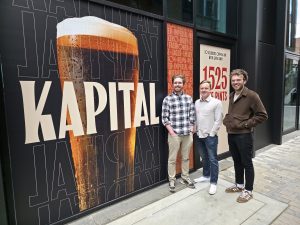End of an era as the last Land Rover Defenders roll off the production line

THE last Land Rover Defender rolls off the production line in Solihull today bringing the curtain down on a motoring legend. Duncan Tift looks back over the last seven decades of the vehicle that progressed from farming runaround to Royal favourite.
THE term ‘icon’ is over-used in modern English – I know this because as a journalist I’m guilty of hyperbole on a regular basis. However, today I am confident I can apply the epithet with absolute certainty and the icon in question is the Land Rover Defender.
Today marks the end of an automotive success story stretching all the way back to the austere days of post-war Britain when an enterprising automotive engineer named Maurice Wilks drew a sketch in the sand on a North Wales beach of a simple utilitarian vehicle he could use to drive around his Anglesey farm.
At the time he was using an old American Willys Jeep for the farmwork but when his brother Spencer came to visit, the pair put their heads together and came up with the basic four-wheel-drive runaround that would eventually evolve into one of the best-selling vehicles of all time, with more than two million sold.
Wilks’ strategy was a simple one; to create a vehicle that would tackle any terrain thrown at it. This principle has been at the forefront of the Land Rover brand ever since that first sketch in the sand and it is an ethos that has helped to spawn future generations of the best 4×4 by far.
To counter the shortage of steel in post-war Britain, the Wilks brothers opted to clad the Land Rover in aluminium alloy, which was in plentiful supply and had the added benefit of being lightweight and resistant to corrosion.
Production proper began at Solihull in the summer of 1948. The original model was powered by a 1595cc engine that drove a permanent four-wheel drive transmission with low ratio gearing to increase off-road capability – a hallmark of every Land Rover to come.
What had once been considered as a stop gap until Rover could introduce a new post-war car, ended up being produced in greater numbers than the Rover themselves – an event anticipated by the board as early as November 1948.
In 1949, the British Army ordered its first Land Rovers, quickly realising that the car could fulfil all of the roles of the complex and more expensive Austin Champ. The British Armed Forces eventually adopted Land Rovers in many different forms as their standard four-wheel drive vehicle.
Over the years, more than two million of the vehicles have been produced and the company confidently says that more than 60% of them are still on the road somewhere.
Over its 68 year lifecycle, the vehicle has been sold into virtually every country in the world, with many of them converted for special use.
I was lucky enough to be invited to an event at the Packington Estate, just outside Solihull, for an event to celebrate Land Rover’s 65th anniversary and to say I felt like the kid who had been given the keys to the toy shop is an understatement.
Around 150 heritage Land Rovers were shown off in the grounds of the estate, which was the testing ground for the original 1947-48 Land Rover prototypes right through to the Range Rover development vehicles of the late 1960’s and early 70’s.
Speaking at the event was John Edwards, then Land Rover’s Global brand director and now head of its Special Vehicles Operations unit.
He said: “Since 1948, every component in our vehicles has been designed and engineered with intent and Land Rover continues to this day, to build the world’s most capable all-purpose vehicles. A blend of refinement, performance and unmatched all-terrain capability make Land Rover vehicles distinctive and unique, ready to tackle the world’s most challenging and inhospitable terrain.”
“Investing in innovation has always been the lifeblood of Land Rover and we will continue to develop innovative new technology and sustainable motoring solutions for the future, whilst retaining the class-leading and legendary breadth of capability that Land Rover’s heritage is built upon.”
As the sun now sets on the Defender, Land Rover diehards are eagerly awaiting its replacement and while there have been several concepts down the years nothing has ever materialised.
But then with the rugged reputation and reliability of the brand, together with the devotion of its loyal owners, one thing is for sure, the old Defender will still be around for a long time to come.
While a new Heritage Line has been created at Land Rover so future generations can review the history of the famous vehicle to ensure its legacy is not forgotten.
Land Rover Timeline
1948 – The Land Rover Series 1 makes its debut
1949 – The British Army orders its first Land Rovers
1955 – A group of young explorers puts the vehicle through its paces by completing an 18,000-mile expedition from Solihull to Malaya via India, over the jungle-clad mountains of Assam, across northern Burma to Thailand and the eventually into Malaya
1957 – The diesel engine is first installed in the model
1966 – The 500,000th Land Rover is produced
1970 – The Range Rover is launched
1972 – A British Army team, led by Major John Blashford-Snell, affirmed the all-terrain properties of the original Range Rover by driving two cars from the north of Alaska to the southernmost tip of Argentina, crossing the infamous Darién Gap
1976 – The one millionth Land Rover is produced
1981 – The four-door Range Rover is launched
1989 – The third Land Rover model, the Discovery is launched
1990 – The original Landie is renamed Defender to reflect the different models now available
1997 – The Freelander, Land Rover’s fourth model is launched
2005 – The Range Rover Sport is launched
2008 – Tata purchases Jaguar and Land Rover from Ford for £1.15bn
2010 – The Range Rover Evoque, a variant of the LRX concept is put into production
2011 – DC100 concept – billed as the Defender replacement – is exhibited in Frankfurt
2012 – The all-new aluminium Range Rover is put into production following massive investment in new production facilities at Lode Lane
2013 – The all-new Range Rover Sport also goes on sale
2014 – JLR’s new Engine Manufacturing Centre is officially opened by HM The Queen
2015 – Launch of the Discovery Sport
2016 – Final production of the Defender
You may also be interested in:
Drive safe with Mercedes Benz as Ford tries to destroy its family-friendly image
Jaguar unveils special XF and Caterham gets its lightweight sports car out

.jpg?access=3648T3124T840)
.jpg?access=667T712T840)







